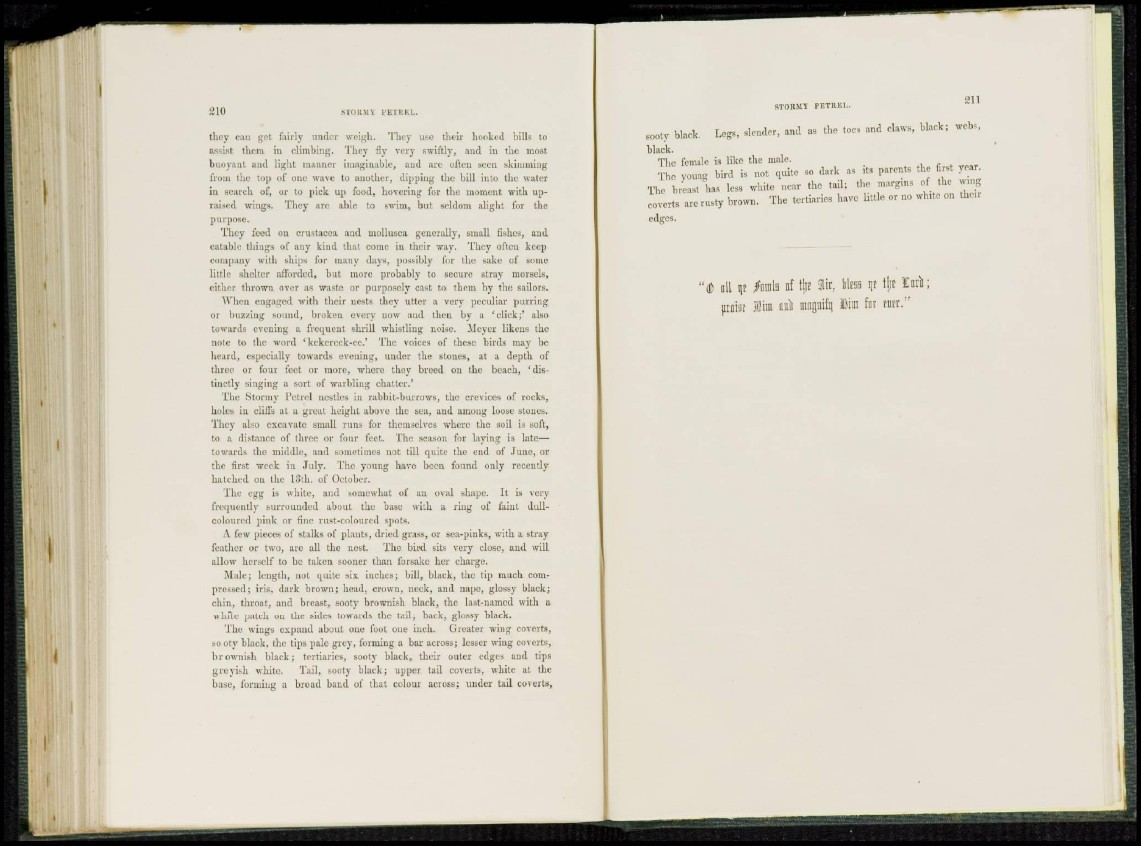
210 STORMY PETREL.
they can get fairly under weigh. They use their hooked bills to
assist them in climbing. They fly very swiftly, and in the most
buoyant and light manner imaginable, and are often seen skimming
from the top of one wave to another, dipping the bill into the water
in search of, or to pick up food, hovering for the moment with upraised
wings. They are able to swim, but seldom alight for the
purpose.
They feed on Crustacea and mollusca generally, small fishes, and
eatable things of any kind that come in their way. They often keep
company with ships for many days, possibly for the sake of some
Little shelter afforded, but more probably to secure stray morsels,
either thrown over as waste or purposely cast to them by the sailors.
When engaged with their nests they utter a very peculiar purring
or buzzing sound, broken every now and then by a 'click;' also
towards evening a frequent shrill whistling noise. Meyer likens the
note to the word ' kekereck-ee.' The voices of these birds may be
heard, especially towards evening, under the stones, at a depth of
three or four feet or more, where they breed on the beach, * distinctly
singing a sort of warbling chatter.'
The Stormy Petrel nestles in rabbit-burrows, the crevices of rocks,
holes in cliffs at a great height above the sea, and among loose stones.
They also excavate small runs for themselves where the soil is soft,
to a distance of three or four feet. The season for laying is late—
towards the middle, and sometimes not till quite the end of June, or
the first week in July. The young have been found only recently
hatched on the loth, of October.
The egg is white, and somewhat of an oval shape. It is very
frequently surrounded about the base with a ring of faint dullcoloured
pink or fine rust-coloured spots.
A few pieces of stalks of plants, dried grass, or sea-pinks, with a stray
feather or two, are all the nest. The biitl sits very close, and will
allow herself to be taken sooner than forsake her charge.
Male; length, not quite six inches; bill, black, the tip much compressed;
iris, dark brown; head, crown, neck, and nape, glossy black;
chin, throat, and breast, sooty brownish black, the last-named with a
while patch on the sides towards the tail; back, glossy black.
The wings expand about one foot one inch. Greater wing coverts,
sooty black, the tips pale grey, forming a bar across; lesser wing coverts,
b r ownish black; tertiarics, sooty black, their outer edges and tips
greyish white. Tail, sooty black; upper tail coverts, white at the
base, forming a broad band of that colour across; under tail coverts,
STORMY PETREL.
sooty black. Legs, slender, and as the toes and claws, black; webs,
black.
The female is like the male.
The young bird is not quite so dark as its parents the first year.
The breast has less white near the tail; the margms of the wing
coverts are rusty brown. The tertiaries have httle or no white on thou
edges.
'cD nil t | t I'oiuls nf t i p ? a i r , l t a ijt Hit Inri;
(irnisf ®im rail mngnifi) IMin for mi."